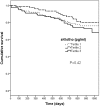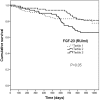Prognostic value and link to atrial fibrillation of soluble Klotho and FGF23 in hemodialysis patients - PubMed (original) (raw)
Clinical Trial
Prognostic value and link to atrial fibrillation of soluble Klotho and FGF23 in hemodialysis patients
Albina Nowak et al. PLoS One. 2014.
Abstract
Deranged calcium-phosphate metabolism contributes to the burden of morbidity and mortality in dialysis patients. This study aimed to assess the association of the phosphaturic hormone fibroblast growth factor 23 (FGF23) and soluble Klotho with all-cause mortality. We measured soluble Klotho and FGF23 levels at enrolment and two weeks later in 239 prevalent hemodialysis patients. The primary hypothesis was that low Klotho and high FGF23 are associated with increased mortality. The association between Klotho and atrial fibrillation (AF) at baseline was explored as secondary outcome. AF was defined as presence of paroxysmal, persistent or permanent AF. During a median follow-up of 924 days, 59 (25%) patients died from any cause. Lower Klotho levels were not associated with mortality in a multivariable adjusted analysis when examined either on a continuous scale (HR 1.25 per SD increase, 95% CI 0.84-1.86) or in tertiles, with tertile 1 as the reference category (HR for tertile two 0.65, 95% CI 0.26-1.64; HR for tertile three 2.18, 95% CI 0.91-2.23). Higher Klotho levels were associated with the absence of AF in a muItivariable logistic regression analysis (OR 0.66 per SD increase, 95% CI 0.41-1.00). Higher FGF23 levels were associated with mortality risk in a multivariable adjusted analysis when examined either on a continuous scale (HR 1.45 per SD increase, 95% CI 1.05-1.99) or in tertiles, with the tertile 1 as the reference category (HR for tertile two 1.63, 95% CI 0.64-4.14; HR for tertile three 3.91, 95% CI 1.28-12.20). FGF23 but not Klotho levels are associated with mortality in hemodialysis patients. Klotho may be protective against AF.
Conflict of interest statement
Competing Interests: The authors declare that TECOmedical AG, Switzerland measured the soluble Klotho and FGF23 levels in their hemodialysis cohort for this study. The authors of this manuscript have no commercial or professional association with TECOmedical AG. They have nothing to declare concerning employment, consultancy, patents, products in development, marketed products, etc. This does not alter the authors’ adherence to PLOS ONE policies on sharing data and materials.
Figures
Figure 1. Cumulative survival by tertiles of secreted Klotho.
Patients were stratified by their baseline Klotho levels according to the tertiles. Kaplan-Meier analysis with long-rank test did not reveal a significant difference between groups (P = 0.42).
Figure 2. Cumulative survival by tertiles of Fibroblast growth factor 23 (FGF23).
Patients were stratified by their FGF23 levels according to the tertiles. Kaplan-Meier analysis with long-rank test approached a significant difference between groups (P = 0.05).
Figure 3. Klotho and FGF23 levels in patients with and without atrial fibrillation.
Figure 4. Klotho (A) and FGF23 (B) levels in controls versus hemodialysis patients.
Similar articles
- Lower soluble Klotho and higher fibroblast growth factor 23 serum levels are associated with episodes of atrial fibrillation.
Mizia-Stec K, Wieczorek J, Polak M, Wybraniec MT, Woźniak-Skowerska I, Hoffmann A, Nowak S, Wikarek M, Wnuk-Wojnar A, Chudek J, Więcek A. Mizia-Stec K, et al. Cytokine. 2018 Nov;111:106-111. doi: 10.1016/j.cyto.2018.08.005. Epub 2018 Aug 20. Cytokine. 2018. PMID: 30138898 Clinical Trial. - FGF23-klotho axis, bone fractures, and arterial stiffness in dialysis: a case-control study.
Desbiens LC, Sidibé A, Ung RV, Fortier C, Munger M, Wang YP, Bisson SK, Marquis K, Agharazii M, Mac-Way F. Desbiens LC, et al. Osteoporos Int. 2018 Oct;29(10):2345-2353. doi: 10.1007/s00198-018-4598-2. Epub 2018 Jun 29. Osteoporos Int. 2018. PMID: 29959497 - Impact of parathyroidectomy on serum FGF23 and soluble Klotho in hemodialysis patients with severe secondary hyperparathyroidism.
Takahashi H, Komaba H, Takahashi Y, Sawada K, Tatsumi R, Kanai G, Suzuki H, Kakuta T, Fukagawa M. Takahashi H, et al. J Clin Endocrinol Metab. 2014 Apr;99(4):E652-8. doi: 10.1210/jc.2013-4050. Epub 2014 Jan 29. J Clin Endocrinol Metab. 2014. PMID: 24476081 Clinical Trial. - Fibroblast growth factor 23/klotho axis in chronic kidney disease.
Nitta K, Nagano N, Tsuchiya K. Nitta K, et al. Nephron Clin Pract. 2014;128(1-2):1-10. doi: 10.1159/000365787. Epub 2014 Nov 8. Nephron Clin Pract. 2014. PMID: 25402964 Review. - FGF23 and Klotho in chronic kidney disease.
Olauson H, Larsson TE. Olauson H, et al. Curr Opin Nephrol Hypertens. 2013 Jul;22(4):397-404. doi: 10.1097/MNH.0b013e32836213ee. Curr Opin Nephrol Hypertens. 2013. PMID: 23666415 Review.
Cited by
- Enhanced Klotho availability protects against cardiac dysfunction induced by uraemic cardiomyopathy by regulating Ca2+ handling.
Navarro-García JA, Rueda A, Romero-García T, Aceves-Ripoll J, Rodríguez-Sánchez E, González-Lafuente L, Zaragoza C, Fernández-Velasco M, Kuro-O M, Ruilope LM, Ruiz-Hurtado G. Navarro-García JA, et al. Br J Pharmacol. 2020 Oct;177(20):4701-4719. doi: 10.1111/bph.15235. Epub 2020 Sep 15. Br J Pharmacol. 2020. PMID: 32830863 Free PMC article. - FGF-23 and cardiovascular disease: review of literature.
Batra J, Buttar RS, Kaur P, Kreimerman J, Melamed ML. Batra J, et al. Curr Opin Endocrinol Diabetes Obes. 2016 Dec;23(6):423-429. doi: 10.1097/MED.0000000000000294. Curr Opin Endocrinol Diabetes Obes. 2016. PMID: 27652999 Free PMC article. Review. - Meta-Analysis of the Association between Fibroblast Growth Factor 23 and Mortality and Cardiovascular Events in Hemodialysis Patients.
Gao S, Xu J, Zhang S, Jin J. Gao S, et al. Blood Purif. 2019;47 Suppl 1(Suppl 1):24-30. doi: 10.1159/000496220. Epub 2019 Jan 30. Blood Purif. 2019. PMID: 30699419 Free PMC article. - Association between Serum Soluble Klotho Levels and Mortality in Chronic Hemodialysis Patients.
Otani-Takei N, Masuda T, Akimoto T, Honma S, Watanabe Y, Shiizaki K, Miki T, Kusano E, Asano Y, Kuro-O M, Nagata D. Otani-Takei N, et al. Int J Endocrinol. 2015;2015:406269. doi: 10.1155/2015/406269. Epub 2015 Oct 28. Int J Endocrinol. 2015. PMID: 26604925 Free PMC article. - Fibroblast Growth Factor-23-Klotho Axis in Cardiorenal Syndrome: Mediators and Potential Therapeutic Targets.
Navarro-García JA, González-Lafuente L, Fernández-Velasco M, Ruilope LM, Ruiz-Hurtado G. Navarro-García JA, et al. Front Physiol. 2021 Nov 15;12:775029. doi: 10.3389/fphys.2021.775029. eCollection 2021. Front Physiol. 2021. PMID: 34867481 Free PMC article. Review.
References
- Shroff GR, Frederick PD, Herzog CA (2012) Renal failure and acute myocardial infarction: clinical characteristics in patients with advanced chronic kidney disease, on dialysis, and without chronic kidney disease. A collaborative project of the United States Renal Data System/National Institutes of Health and the National Registry of Myocardial Infarction. Am Heart J 163: 399–406. - PMC - PubMed
- Drueke TB (2010) Klotho, FGF23, and FGF receptors in chronic kidney disease: a yin-yang situation? Kidney Int 78: 1057–1060. - PubMed
- Urakawa I, Yamazaki Y, Shimada T, Iijima K, Hasegawa H, et al. (2006) Klotho converts canonical FGF receptor into a specific receptor for FGF23. Nature 444: 770–774. - PubMed
- Imura A, Iwano A, Tohyama O, Tsuji Y, Nozaki K, et al. (2004) Secreted Klotho protein in sera and CSF: implication for post-translational cleavage in release of Klotho protein from cell membrane. FEBS Lett 565: 143–147. - PubMed
Publication types
MeSH terms
Substances
Grants and funding
The authors thank TECOmedical AG, Switzerland for measurements of soluble Klotho and FGF23 levels. The funders had no role in study design, data collection and analysis, decision to publish, or preparation of the manuscript. In addition to the above, there was no other funding for this study. The authors’ organisations had no other external or internal funding.
LinkOut - more resources
Full Text Sources
Other Literature Sources
Medical



